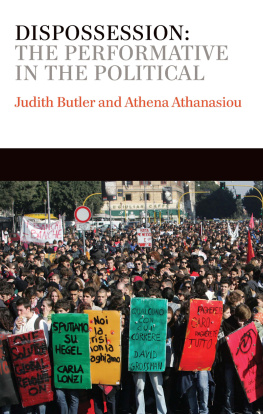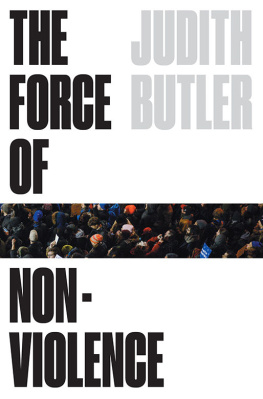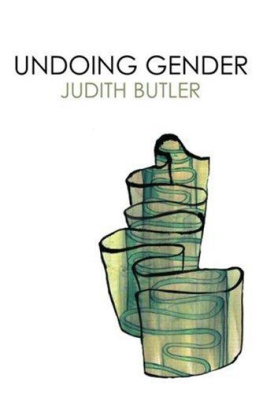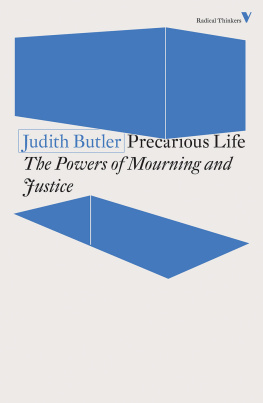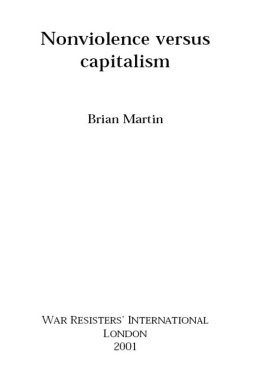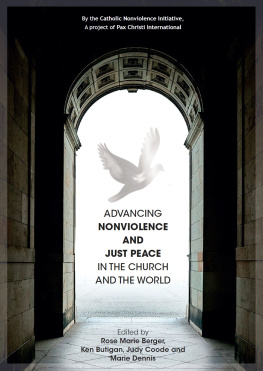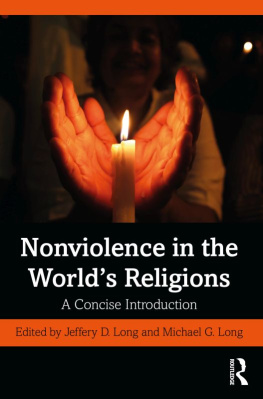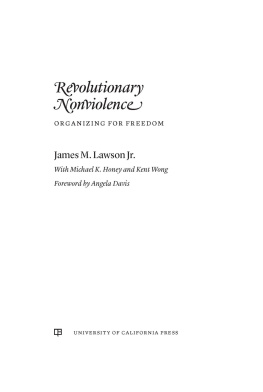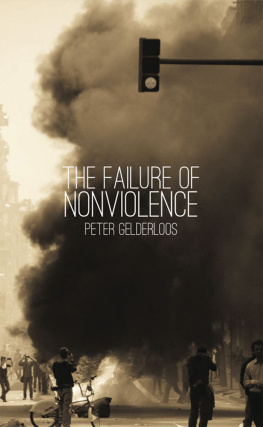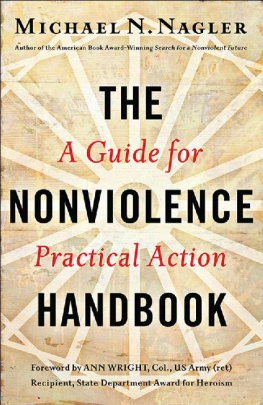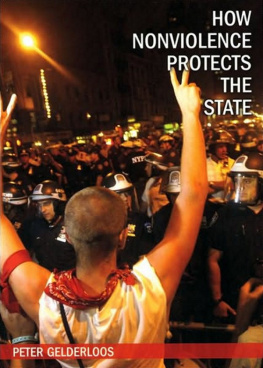Contents
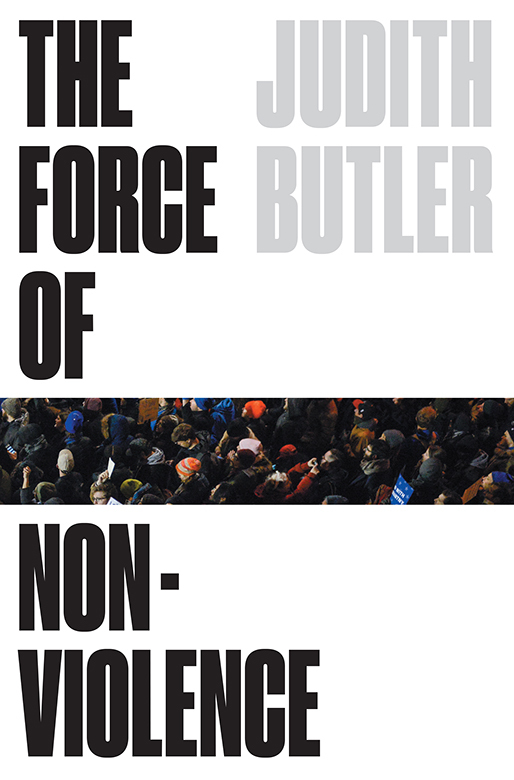
THE FORCE OF NONVIOLENCE
THE FORCE OF
NONVIOLENCE
An Ethico-Political Bind
Judith Butler

This paperback edition published by Verso 2021
First published by Verso 2020
Judith Butler 2020, 2021
All rights reserved
The moral rights of the author have been asserted
1 3 5 7 9 10 8 6 4 2
Verso
UK: 6 Meard Street, London W1F 0EG
US: 20 Jay Street, Suite 1010, Brooklyn, NY 11201
versobooks.com
Verso is the imprint of New Left Books
ISBN-13: 978-1-78873-277-2
ISBN-13: 978-1-78873-278-9 (UK EBK)
ISBN-13: 978-1-78873-279-6 (US EBK)
British Library Cataloguing in Publication Data
A catalogue record for this book is available from the British Library
The Library of Congress Has Cataloged the Hardback Edition As Follows:
Names: Butler, Judith, 1956- author.
Title: The force of nonviolence : an ethico-political bind / Judith Butler.
Description: Brooklyn : Verso Books, 2020. | Includes index. | Summary:
Situating non-violence at the cross-roads of the ethical and political, The Force of Non-Violence brings into focus the ethical binds that emerge within the force field of violence. Non-violence is very often misunderstood as a passive practice that emanates from a calm region of the soul, or as an individualist ethic with an unrealistic relation to existing forms of power. This book argues for an aggressive form of non-violence that struggles with psychic ambivalence and seeks to embody social ideals of inter-dependency and equality. Only through a critique of individualism can the ethical and political ideal of non-violence be understood in relation to the ideal of equality and the demand for grievability. In this psychosocial and philosophical reflection that draws upon Foucault, Fanon, Freud, and Benjamin, Butler argues that to oppose violence now requires understanding its different modalities, including the regulation of the grievability of lives. The book shows how racial and demographic phantasms enter into the rationale for inflicting state violence and other modes of letting die by investing violence in those who are most severely exposed to its effects and subjugated to its lethal power. The struggle for non-violence is found in modes of resistance and movements for social transformation that separate off aggression from its destructive aims to affirm the living potentials of radical egalitarian politics-- Provided by publisher.
Identifiers: LCCN 2019038460 (print) | LCCN 2019038461 (ebook) | ISBN
9781788732765 (hardback) | ISBN 9781788732796 (ebook)
Subjects: LCSH: Nonviolence--Moral and ethical aspects. | Nonviolence. | Individualism.
Classification: LCC BJ1459.5 .B88 2020 (print) | LCC BJ1459.5 (ebook) | DDC 179.7--dc23
LC record available at https://lccn.loc.gov/2019038460
LC ebook record available at https://lccn.loc.gov/2019038461
Typeset in Adobe Garamond by Hewer Text UK Ltd, Edinburgh
Printed and bound by CPI Group (UK) Ltd, Croydon CR0 4YY
Whenever and to whatever extent there is room for the use of arms or physical force or brute force, there and to that extent is there so much less possibility for soul force.
Mahatma Gandhi
The choice today is no longer between violence and nonviolence. It is either nonviolence or nonexistence.
Martin Luther King, Jr.
The legacy (of nonviolence) is not that of an individual legacy but a collective legacy of vast people who stood together in unity to proclaim that they would never surrender to forces of racism and inequality.
Angela Davis
Contents
I am thankful to audiences and respondents who heard earlier versions of these chapters as the Tanner Lectures at Yale University in 2016, the Gifford Lectures at the University of Glasgow in 2018, and the Cuming Lectures at University College Dublin in 2019. I thank, as well, audiences and colleagues for their critical engagement at the Centre de Cultura Contempornia de Barcelona, University of Zurich, Sciences Po in Paris, Meiji University in Tokyo, the Free University of Amsterdam, the Institute for Philosophy and Social Theory at the University of Belgrade, the Institute for Critical Social Inquiry at the New School for Social Research, WISER at the University of the Witwatersrand, the Psychology and the Other conference in Cambridge in 2015, and the Modern Language Association meetings in 2014. I am most thankful to my students at the University of California, Berkeley, and my colleagues in the International Consortium of Critical Theory Programs, who have kept my mind sharper than it otherwise would have been. As always, I thank Wendy Brown for the joyful company of her intelligence, and for her enduring support. I dedicate this book to a friend and colleague precious to the UC Berkeley community, Saba Mahmood. Of course, she would have disagreed with my argument here, and I would have treasured that exchange.
appeared in earlier form in Richard G. T. Gipps and Michael Lacewing, eds., The Oxford Handbook of Philosophy and Psychoanalysis , Oxford: Oxford University Press, 2019.
The case for nonviolence encounters skeptical responses from across the political spectrum. There are those on the left who claim that violence alone has the power to effect radical social and economic transformation, and others who claim, more modestly, that violence should remain one of the tactics at our disposal to bring about such change. One can put forth arguments in favor of nonviolence or, alternately, the instrumental or strategic use of violence, but those arguments can only be conducted in public if there is general agreement on what constitutes violence and nonviolence. One major challenge faced by those in favor of nonviolence is that violence and nonviolence are disputed terms. For instance, some people call wounding acts of speech violence, whereas others claim that language, except in the case of explicit threats, cannot properly be called violent. Yet others hold to restrictive views of violence, understanding the blow as its defining physical moment; others insist that economic and legal structures are violent, that they act upon bodies, even if they do not always take the form of
It seems like it should be easy to simply oppose violence and allow such a statement to summarize ones position on the matter. But in public debates, we see that violence is labile, its semantics appropriated in ways that call to be contested. States and institutions sometimes call violent any number of expressions of political dissent, or of opposition to the state or the authority of the institution in question. Demonstrations, encampments, assemblies, boy-cotts, It is both curious and appalling to see how the defense of violence works under such conditions, for the target has to be figured as a threat, a vessel of real or actual violence, in order for lethal police action to appear as self-defense. If the person was not doing anything demonstrably violent, then perhaps the person is simply figured as violent, as a violent kind of person, or as pure violence embodied in and by that person. The latter claim manifests racism more often than not.
What starts, then, as an apparently moral argument about whether to be for or against violence quickly turns into a debate about how violence is defined and who is called violentand for what purposes. When a group assembles to oppose censorship or the lack of democratic freedoms, and the group is called a mob, or is understood as a chaotic or destructive threat to the social order, then the group is both named and figured as potentially or actually violent, at which point the state can issue a justification to defend society against this violent threat. When what follows is imprisonment, injury, or killing, the violence in the scene emerges as state violence. We can name state violence as violent even though it has used its own power to name and to represent the dissenting power of some group of people as violent. Similarly, a peaceful demonstration such as that which took place in Gezi Park in Istanbul in 2013, can be effectively figured and represented as a violent act only if the state either has its own media or exercises sufficient control over the media. Under such conditions, exercising rights of assembly is called a manifestation of terrorism, which, in turn, calls down the state censor, clubbing and spraying by the police, termination of employment, indefinite detention, imprisonment, and exile.


